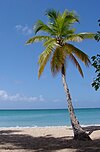bio.wikisort.org - Plant
Barcella is a monotypic genus of flowering plant in the palm family found in the States of Amazonas and Roraima in northwestern Brazil.[2] The only known species is Barcella odora which is used by the Brazilian peoples in construction and for various thatched goods.
| Barcella | |
|---|---|
| Scientific classification | |
| Kingdom: | Plantae |
| Clade: | Tracheophytes |
| Clade: | Angiosperms |
| Clade: | Monocots |
| Clade: | Commelinids |
| Order: | Arecales |
| Family: | Arecaceae |
| Subfamily: | Arecoideae |
| Tribe: | Cocoseae |
| Genus: | Barcella (Trail) Trail ex Drude[1] |
| Species: | B. odora |
| Binomial name | |
| Barcella odora (Trail) Drude | |
| Synonyms[2] | |
|
Elaeis odora Trail | |
Description
The unarmed trunks of Barcella odora usually remain underground, producing 2 m arching leaves with pendent, lanceolate leaflets, 60 cm long and dark green in color. The leaflets are regularly arranged along the rachis, once-folded, with a prominent midrib and a tapering apex. They are monoecious with male and female flowers on a single plant, the interfoliar inflorescences are once branched with both pistilate and staminate flowers containing three sepals and three petals. The 3 cm ovoid fruit mature to a bright orange color each with one seed.
Barcella and the closely related genus Elaeis form a taxon within Cocoseae represented by their large pistilate flowers sunken in the rachillae, as well as endocarp pores. Elaeis is distinguished from Barcella by the presence of petiole spines and a fibrous, rather than woody, bract.[3]
Distribution and habitat
These palms are found at low altitudes along the Rio Negro river and its tributaries, growing in campinarana (sandy scrubland).[4]
References
- (Trail) Trail ex Drude in Martius, Flora Brasiliensis 3(2):459. 1881 Type:B. odora
- Kew World Checklist of Selected Plant Families
- Uhl, Natalie W. and Dransfield, John (1987) Genera Palmarum - A classification of palms based on the work of Harold E. Moore. Lawrence, Kansas: Allen Press. ISBN 0-935868-30-5 / ISBN 978-0-935868-30-2
- Riffle, Robert L. and Craft, Paul (2003) An Encyclopedia of Cultivated Palms. Portland: Timber Press. ISBN 0-88192-558-6 / ISBN 978-0-88192-558-6
External links
Другой контент может иметь иную лицензию. Перед использованием материалов сайта WikiSort.org внимательно изучите правила лицензирования конкретных элементов наполнения сайта.
WikiSort.org - проект по пересортировке и дополнению контента Википедии
